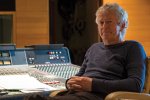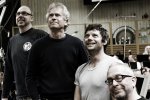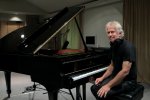"7 + 6 + 5 = 18 Pieces for Orchestra" - The Naxos re-issue of Tony Banks' orchestral albums reviewed by Alan Hewitt. Photographs courtesy of Tadlow Music and Emily Banks.
Well, after that lesson in basic mathematics, what does the music in this lovely little box set offer? Let’s see.
I think that many Genesis/Tony Banks fans are usually unfairly dismissive of anything outside their comfort zone and orchestral music is most definitely outside the comfort zone of your average Prog fan. Am I being unfair there myself? Not from my experience but no offence intended anyway. Me? I inhabited the orchestral world long before I came to Prog and so this journey has been an easy one for me.
Tony’s own journey into the world of orchestral music was not exactly an easy one. Beginning with the (in)famous Wicked Lady soundtrack which certainly showcased Tony’s compositional talents and when reissued on the short-lived Fugitive Inc imprint certainly displayed that talent. The compositions therein certainly deserved a better fate than the one they received as part of that film. |
|
Anyway, that experience, and his disappointments with film soundtrack work in general along with his still ongoing commitments to recording and touring with Genesis meant that anyone hoping he might dip his toe into the orchestral pool again was in for a long wait.
Tony finally reappeared as an orchestral composer in 2004 with Seven – A Suite For Orchestra. This first foray was surprisingly satisfying and demonstrated Tony’s grasp of orchestral form and colours.
Spring Tide, the album’s opener is a delight with shades of Elgar and Debussy all wrapped up inside Tony Banks’ sonorities, a dramatic and by turns delicate opener. Black Down is a nod to a local feature in the landscape where Tony lives, ethereal and dramatic, a mist enshrouded landscape, very Impressionistic use of the orchestra here to give an almost cinematic feel to the piece whilst in its style it clearly echoes the work of Vaughan Williams and in particular his third “Pastoral” Symphony.
The Gateway to me, has echoes of The Great Gate Of Kiev, not so much in its dramatic effect but the chiming of a bell, a great city waking up to the new day as the gates are opened for the citizens The Ram is all swagger and bluster perfectly in keeping with it’s namesake - a very swashbuckling feel to this one. It could easily have been used in one of the Pirates Of The Caribbean films as it describes Jack Sparrow to a T! |
|
|
Eathlight meanwhile is all shimmering chords and delicately balanced combinations of strings and woodwind, a piece Debussy would have been proud of although the trumpet towards the end once again reminds me of Vaughan Williams and of course, there is a nod to one of Tony’s own Prog compositions there too – see if you can guess which one!
Neap Tide combines the forces of the orchestra in a vigorous and yet restrained piece before we get to the finale: The Spirit Of Gravity. Another epic clocking in at almost twelve minutes. Some may say this is long enough, I disagree, I think that Tony could easily have gone on to create a symphony or an overture out of this one, although it is, of course long enough to be classed as the latter. There is a lot going on in this piece and it really moves around with varying moods and atmospheres and emotions incredibly well drawn together bringing the album to a suitably evocative close.
Fans were to wait a further eight years before Tony returned with his next orchestral offering: Six Pieces For Orchestra which gets under way with Siren and some impressive saxophone work from Tony’s chum, Martin Robertson. Tony paints a vast aural landscape here in keeping with the character he is depicting.
Still Waters is much more restrained and, if you listen carefully, you can hear echoes of some of Tony’s previous work here. Blade features the superb violin work of Charlie Siem and the opening reminds me very much of Saint Saens’ La Danse Macabre – which is no bad thing! This, in a normal circumstance would be an overture in its own right.
Wild Pilgrimage starts deceptively before getting into its swing and, once again, there are echoes of Tony’s past within it. Tony uses a lush and luxurious orchestral palette here and uses it to create a broad vista for our imagination to wander in. The Oracle meanwhile could be viewed as something of a pen portrait of Tony himself; slightly mysterious but with a wry sense of humour..A favourite of mine. |
|
|
The album closes with City Of Gold, no prizes for guessing the Genesis reference in this one eh? The album’s central character finally reaches his journey’s end in fine style. Tony finally came of age as an orchestral composer with this album, and the pieces should, if there is any justice, find their way into the orchestral repertoire.
The final part (so far) of this mathematical equation appeared in 2018 with Five. Opening with the piece which had originally been commissioned for the Cheltenham Festival as “Arpegg” but now renamed as Prelude To A Million Years – a vast cinematic canvas is on display here and results in a luxurious and spacious piece.
Reveille meanwhile, is not a clarion call that you would expect and instead is driven along by an insistent rhythm on a marimba of all things but built upon by the orchestra before the expected trumpet finally makes it’s appearance. Tony always likes to keep us guessing.
Ebb And Flow very much captures the sense of a sea voyage, wistful thoughts of loved ones fill the minds of the ship’s crew as land finally comes into view. Vignettes are superbly etched by members of the orchestra making this one of the most purely descriptive orchestral pieces Tony has penned.
Autumn Sonata does exactly what it says, it describes in music a landscape and the rich hues that autumn provides – for me the New England landscape of Vermont springs to mind but use your own imaginations on this one.
The album is concluded by Renaissance, in which Tony clearly acknowledges his past work in the field of Prog Rock and the overall feel is somewhat elegiac in tone, perhaps an acknowledgement that those days are behind him. |
|
An impressive album, confident and masterful, far removed from the hesitancy which marked it’s predecessors. Tony found his true orchestral voice with this one and it is to be hoped that that voice still has something to say...?
And so there it is, Tony’s orchestral oeuvre to date. An impressive catalogue of work which should be recognised as being worthy of performance within the orchestral repertoire alongside some of the masters of the world of orchestral music.







